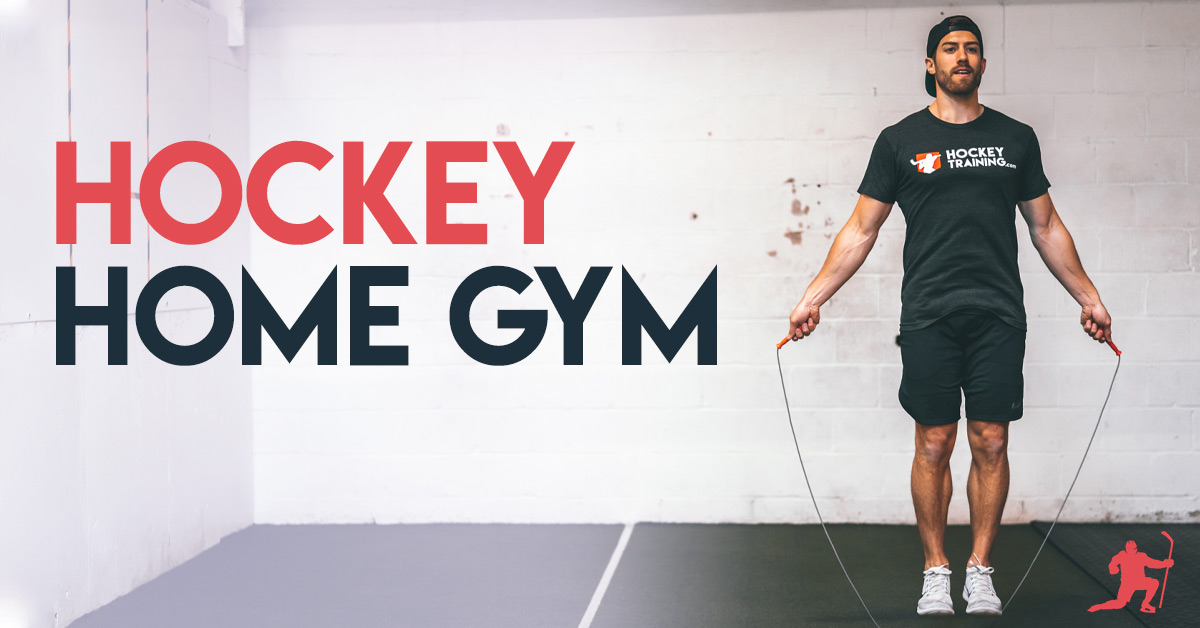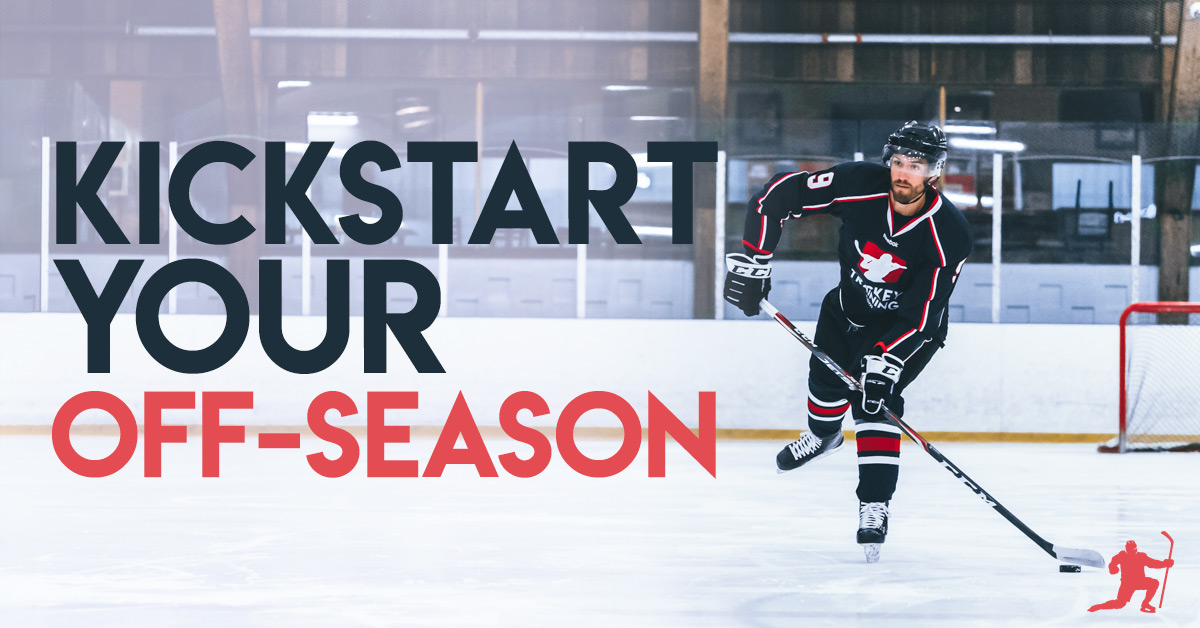In this article, I’m going to show you precisely what you need to be doing to take your youth athlete’s all-around hockey performance to the next level safely and effectively.
Here’s how I’m going to break it down if you want to jump to a specific section:
- Why Kids Should Be Doing Some Dryland Training
- Is Training Safe For Kids?
- Why Kids Shouldn’t Only Play Hockey Year Round
- Fun Games for Hockey Performance
- The Solution To Help Your Kid Become A New And Improved Hockey Player
Look, I shouldn’t have to tell you that if you want to reach your potential in hockey, having a productive off-season is a non-negotiable factor year-in and year-out.
As the old saying goes, “champions are built in the off-season.”
The way I have always described it to my hockey players is that you build your performance in the off-season, and you express that performance in the in-season.
Unless you take time to build upon your development, you will have nothing new to express next season.
A well-designed off-season will improve your on-ice explosive speed, agility, strength, and conditioning all-in-one.
You don’t need to focus on just one goal, yet, all too often, you hear hockey players and/or hockey parents say things such as:
- He needs to gain weight
- She needs to be more explosive
- They need to improve your conditioning
- I want to enhance first-step quickness
Stop saying these things. You’re cutting yourself short and limiting your potential before you even start the off-season.
Instead of narrowing your sights on one goal, attack ALL of the hockey performance qualities logically and progressively to improve your all-around hockey performance.
Hockey athletes aren’t one-dimensional like marathon runners or powerlifters, instead, hockey players need to become the “complete athlete,” and their off-season programming should reflect that through proper phasic scheduling.
Although most people associate off-season training with elite hockey players in their twenties and/or late teens, it’s a significant disadvantage if you wait that long to start.
Youth hockey players can and should undergo off-season programming specific for hockey performance if reaching their potential in this sport is something that they are truly passionate about.
The best part?
If you grab on to this opportunity and train them properly while they are young, it will have an impact on the trajectory of their entire hockey career and give them an almost unfair advantage over the other players on the ice.
Don’t believe me?
Let’s talk sports science and break down why now more than ever it’s important to hop on a youth-specific hockey training program.
Why Kids Should Be Doing Some Dryland Training
When an athlete is young, they are still in a critical period where their nervous system is being molded like clay.
This is very important to care about because how your nervous system functions largely govern the quality of your coordination, balance, and movement patterns during physical activity.
When a kid is exposed to a new movement pattern, it comes much more naturally to them than their adult counterparts.
It’s comparable to learning a new language, kids learn much faster and more naturally as they are still growing. In contrast, it is incredibly difficult for an adult to just “pick up” a new language.
Furthermore, their nervous system can “download” these movement patterns and hold on to them for the rest of their life (just like you would remember a language).
Yet, this window for nervous system adaptability seems to close during the onset of puberty.
Meaning, the best chance you have in your entire life at improving the athleticism of any human being is during their youth years.
This may sound counter-intuitive because the best athletes in the world are adults, but it is during the youth years where your training has the most significant impact on the trajectory of their entire athletic life.
Exposing youth hockey players to as many new movement patterns as possible at a young age increases the “hard drive” memory space they have for all of these “downloaded” movement patterns.
This is why cross-training (performing multiple sports at a young age) destroys specialization (only ever playing one sport year-round) within the sports science literature for producing the highest-level athletes later in life.
Athletes who have developed many different movement patterns throughout their nervous system adaptability days have access to more tools in an athletic setting (i.e. a hockey game) than an athlete who wasn’t exposed to as many patterns.
To make this point super simple, just think about a really good athlete you know personally in your life and a really bad athlete you know as well.
I’m willing to bet my house on the fact that the really good athlete played many different sports and excelled throughout his/her youth and after puberty as well.
Whereas the bad athlete… they “hung in there” during their youth years even though they weren’t the best, but then fell way behind everyone else once puberty set-in.
The great athlete played many sports and has many movement patterns downloaded into their physiology that he/she can call upon at a moment’s notice in a natural/athletic way out on the ice.
Whereas the bad athlete does not move nearly as well and remains that way for the rest of his/her life because their nervous system is “locked in.”
Have you ever met somebody who was a terrible athlete when they were 15, but then turned into an elite athlete in their adult years?
Me neither and this nervous system development is why you see this trend all around you.
Want to know the best part?
Proper off-season hockey training exposes youth athletes to hundreds of new movement patterns that they can master, which will give them the jack-of-all-trades nervous system adaptability that you want while simultaneously building up their speed, conditioning, agility, and strength in a hockey-specific way.
I’m going to tell you something I don’t want you to ever forget — a pyramid can only peak as high as the foundation is wide.
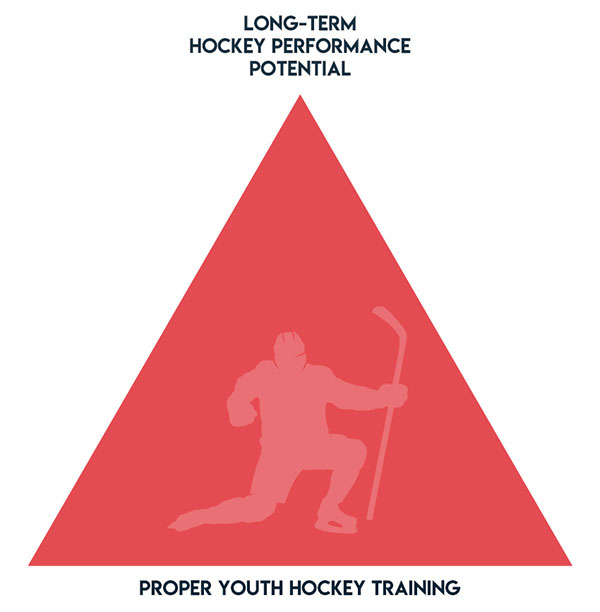
Your nervous system development represents your athletic foundation, which, in turn, determines the peak potential of your hockey performance for a lifetime.
Now is the time, more than ever, to do proper youth hockey training.
Is Training Safe For Kids?
We often get asked here at Hockey Training whether or not it is safe for younger athletes to do some training to become a better hockey player.
To be honest, this is an excellent question because every parent only wants what’s absolutely best for their young ones.
In this section, I want to address this topic head-on so that we can end the controversy surrounding what’s really holding young players back from becoming the best versions of themselves.
Let’s start with the most common question:
“Does training at a young age stunt their growth?”
The topic of training and safety for youth athletes has been circulating for decades, mostly just within the United States and Canada, though as other countries have been routinely training their athletes at a young age for a long time now.
If you’re reading this article, I’m sure you have heard that any form of resistance training is unsafe for the youth demographic.
Some even go as far as saying it is bad for the joints and causes stunted growth and that they’ll remain kid-sized for the rest of their life. Yet, there is literally no evidence to support these claims.
In reality, the safety risks of doing controlled dryland and/or gym-based exercise is far less than doing competitive football, basketball, hockey, running, baseball, gymnastics, martial arts, and many other popular sports.
The research in the world of biomechanics has clearly demonstrated that activities such as throwing, running, jumping, and hitting all impose much larger forces on the body than resistance training ever could.
These activities have also been shown to place more substantial stress on the growth plates of growing bones than resistance training does — yet every parent seems to be ok with letting their kid perform all of these activities simultaneously.
I’d like to take a quick moment here and pull a direct quote an excellent review of the scientific literature that is found within the British Journal of Sports Medicine:
“Of note, injury to growth cartilage has not been reported in any prospective youth resistance training study that provided professional guidance and instruction.
Furthermore, there is no evidence that resistance training will negatively impact growth in height during childhood and adolescence.”
That is powerful stuff and should be incredibly conclusive for you since it is coming from an extremely well-respected medical journal and not just some random person echoing an old myth that needs to die.
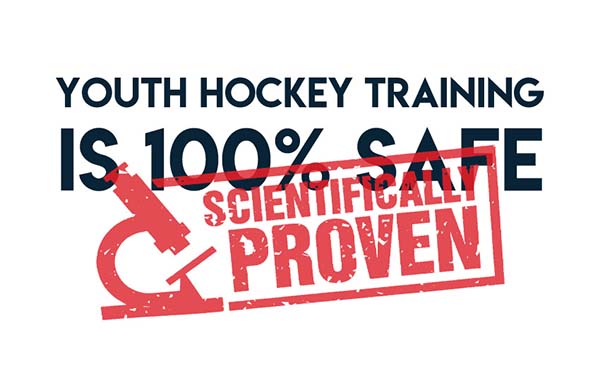
Not only has it been scientifically demonstrated that training at a young age is safe — it’s actually healthier for your body to train rather than not train!
That’s right, studies have shown that youth demographics who resistance train have higher bone densities, which is the main contributor to bone strength (and not plate damage!).
Eastern European countries have found that children are significantly healthier when they resistance train at a young age, and both the American Society of Pediatrics and the American Orthopedic Society for Sports Medicine have said that resistance training is positive for both health and overall development.
Provided the program is made by a professional and that the technique is being supervised to ensure the movements are being performed properly, there seems to be no reason not to train and a whole lot of reasons to train.
To take the health and hockey performance legitimacy to the next level, I’d like to take a quote from the position statement that the National Strength and Conditioning Association did after reviewing the totality of research on youth training program design:
“Despite outdated concerns regarding the safety or effectiveness of youth resistance training, scientific evidence and clinical impressions indicate that youth resistance training has the potential to offer observable health and fitness value to children and adolescents, provided that appropriate training guidelines are followed and qualified instruction is available.
In addition to performance-related benefits, the effects of resistance training on selected health-related measures including bone health, body composition, and sports injury reduction should be recognized by teachers, coaches, parents, and health care providers.”
More incredibly powerful stuff from the most scientifically respected strength and conditioning organization in the world.
If you read that correctly, you would know that not only can it help them with their health markers, and their fat loss, and their bone health, and their muscle gain…
But it also leads to fewer injuries in sports, not more!
By combining everything we have discussed so far in this article, you can start to see how incredibly effective and safe it is for you to have your hockey players undergo a professionally designed off-season hockey training program.
What To Do When The Hockey Season Ends
When the season/playoffs finish, a lot of kids need a bit of a break from hockey — both psychologically and physically.
Their bodies are a little beat up, and their motivation/drive to give it their all on the ice is running low.
It’s time for a break, or more accurately, we would say it’s time to rest and recover.
As the research continues to come out in sports science, we are beginning to find that active recovery methods are actually superior to doing nothing at all.
Meaning, if you want to recover faster, then it’s beneficial for you to partake in a low-intensity activity on your off-days from training (as opposed to just sitting there and playing video games all day).
It’s counter-intuitive thinking because most people expect that being as lazy as possible allows the body to recover faster, but, light activity improves blood flow to the muscular system and creates a type of “flushing effect” within your sore and damaged muscles.
It helps bring the fatigue by-products out while simultaneously delivering glucose and amino acids to support accelerated repair processes.
Light swimming, going for a bike ride, or just simply going for a hike are all kid-friendly activities that would work really well during this timeframe.
But, I personally like to utilize something I call the “regeneration phase” to act as a post-playoffs active recovery phase for youth hockey players.
It’s designed in a way that facilitates accelerated recovery from the in-season/playoffs because it is low in overall training volume and light in terms of its intensity prescription — but at the same time, I prefer it over other activities (such as the ones listed above) because I can be more specific to the exact needs of a hockey player.
For example, hockey players have notoriously tight hips post-season — instead of having them go on a hike I could have them perform a couple of mobility circuits throughout the week to create the flushing effect that we are after but also unlock their hips while we’re at it.
Two birds with one stone and no time will this be more effective than right at the beginning of the off-season when they are a physical blank canvas.
Now, think about using this active recovery phase to work on the multitude of issues hockey athletes have post-playoffs/season (mobility, structural balance, stability, balance, coordination, injury repair, etc.), it’s really more like 10 birds with one stone.
It also creates a “slingshot effect” going into phase one of the off-season programming.
Let’s say we had two hockey players, and both players were subjected to the exact same stressors during a tough season.
One player decides to sit down and play video games for two weeks and then decides to jump right into phase one of the off-season programming.
Whereas the other player decides to utilize these two weeks for hockey-specific active recovery and works to correct his mobility restrictions.
The player who played video games won’t be as recovered as the one who did a regeneration phase due to active recovery being more effective.
Beyond this, the player who stayed and did a regeneration phase will also be entering the first phase of the off-season without any major mobility restrictions (whereas the video game player will definitely have even tighter hips now from sitting so much).
This is very important to care about because the player who played video games will come back and jump right into movements such as prisoner squats and lunges even though he has tightness, instability, and structural issues all over his body.
This puts him at a much higher risk of injury because he is choosing exercises that he is not ready for yet.
I always say, “If you can’t do it, don’t load it!” — Meaning, if you have restrictions holding back your movement patterns, stay away from doing those movement patterns because you’re only going to reinforce bad technique and increase your risk for injury.
Meanwhile, the athlete with the regeneration phase under his belt won’t have the same issues because he primed himself to take on a harder phase of programming and has all of the movement capability and recovery capacity to handle it well.
He has no physical restrictions and will be able to train at a higher level come time for phase 1, therefore, “slingshotting” himself into having a much more productive off-season.
Why Kids Shouldn’t Only Play Hockey Year Round
One major trend now is the fact that hockey is a year-round sport for many kids.
Some parents and coaches don’t even know what the word “off-season” really means.
Winter league.
Summer league.
High school hockey.
3-on-3 tournaments.
Camps.
Power skating.
It is an exhausting list of on-ice hockey activities that can lead to a handful of things:
- Mental burn out
- Overuse injuries
- Loss of passion for game
- Physical exhaustion
- Stress
- Structural imbalances
- Extreme mobility restrictions
Remember, sometimes, kids need to be kids.
Studies have found some not-so-great associations with early specialization (as we discussed above).
Still, if you are going to specialize, you need to build in some time off throughout the year.
“Time-off” represents time away from the ice and not time away from physical activity.
I think it is safe to say that taking 1-3 months off of hockey in a year will not deplete a child’s skills or capacity to play at an elite level.
In contrast, that time off will allow them to regain a zest for the sport, reduce their chance of overuse injury, develop a more complete nervous system, unlock mobility restrictions, correct structural imbalances, recover properly, and give them time to just enjoy life as a kid.
Two, in particular, I want to zero-in on a little further, being mobility restrictions and structural imbalances.
We haven’t discussed these much yet, but they make up the basis behind how we structure the general approach within the first 1-3 phases of the off-season for youth athletes.
Listen, hockey is a unilateral sport.
Meaning, it is played in a way where you usually are only ever using one side of your body to execute movement.
You’re only rotating your torso in one direction for shots.
You’re only receiving passes on one side.
You propel your body forward, typically with a preferred/dominant take-off leg.
You are holding the stick on the same side of your body with one shoulder always in internal rotation while the other one is constantly in external rotation.
…you get the point here.
Unilateral means one side of the body is active/accelerative, whereas the other side of the body is passive/decelerative.
Of course, there are some exceptions to the above examples, but the point is the same:
Unilateral dominant movement patterns create predictable imbalances in both mobility and structure.
When you have a structural imbalance, you will always have an accompanying tightness – that I can guarantee you.
Tightness plays a significant role in hockey performance development and overall off-season program design. Think about the people in your life; the ones who are super inflexible are also usually the worst athletes.
I can’t think of anybody I have ever met in my whole life who was reaching their athletic potential while still being very tight.
It doesn’t happen. It’s something that will instantly reduce both your stride length and your stride frequency out on the ice.
When you’re tight, you can’t move properly.
When you can’t move properly, that is the first domino that knocks over many dominos from a hockey performance perspective.
It doesn’t just limit your range of motion, either.
It limits your agility, starting speed, top speed, puck handling ability, high-velocity direction change, stretch/reflex potential, and power potential.
All major factors that need to be working in sync to have you perform at your best and reach your potential in this sport.
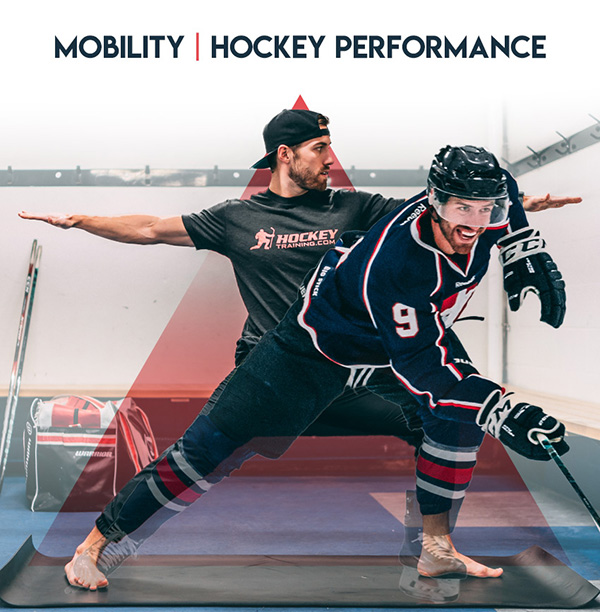
One of the biggest reasons why I address tightness so often through the content here at HockeyTraining.com is the fact that it goes unrecognized in a lot of the hockey world as a legitimate performance potentiator.
Normally people pass it off as “I’m just inflexible,” or the coach will say something like “You have to work on your stretches” without actually giving a well thought out approach to addressing the issues that the athlete presents.
Targeting and improving tightness is a way to improve performance without even changing anything else.
Yes, it is an independent regulator of performance.
This means you could be training the same, eating the same, sleeping the same, and executing your entire routine the same you always have.
But then if you corrected your tightness, even though you’re essentially still the same player, you will perform better on the ice directly because you will be able to move more fluidly.
An enhancement in movement quality will result in an improvement of performance every single time. It doesn’t matter how strong and powerful you are if you can’t move like an athlete.
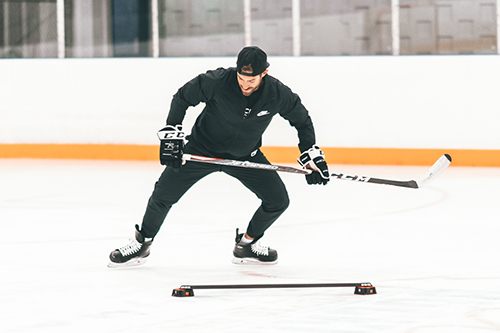
Luckily for us, muscle tightness in hockey is honestly pretty universal. 80% of the players present a lot of the same issues in my experience.
Utilizing the governing principles for mobility regulation, we can assess the biomechanics of hockey to create broad-spectrum guidelines for all youth hockey players rather than place a microscope at each individual’s movement.
Hockey players almost always have:
- Tight hips/hip flexors
- Tight Achilles tendon and calves
- Tight vastus lateralis
- Tight hamstrings (specifically the biceps femoris)
- Tight lower back
- Tight shoulders
These tightness issues have a brother-sister relationship with the structural imbalance problems they create which are:
- Imbalanced core
- Imbalanced rotator cuffs
- Imbalanced quadriceps
- Imbalanced hamstrings
- Imbalanced adductor/abductors
Each one of these issues are targeted and fixed in the beginning stages of the off-season to medicate hockey-specific issues directly, which is something a general exercise program could never do.
Beyond this, too much ice time is what adds gas to the fire for all of the above issues — it’s the repetition that creates the problem, taking time off to fix the issues pays dividends for the rest of the year.
Like the old saying goes, an ounce of prevention equals a pound of cure.
The best part?
Creating balance in an athlete both structurally and with their mobility allows them to move without restrictions out on the ice, which optimizes their edge work, energy efficiency, speed, agility, and overall hockey performance.
Why Bodyweight Training Is Best
Bodyweight exercises are strength training exercises that do not require the addition of any machines, barbells, or dumbbells.
The hockey player’s own weight is what is going to provide the resistance for all of the movements within this type of program design, which is what I heavily prefer for kids for a wide variety of reasons we will get into.
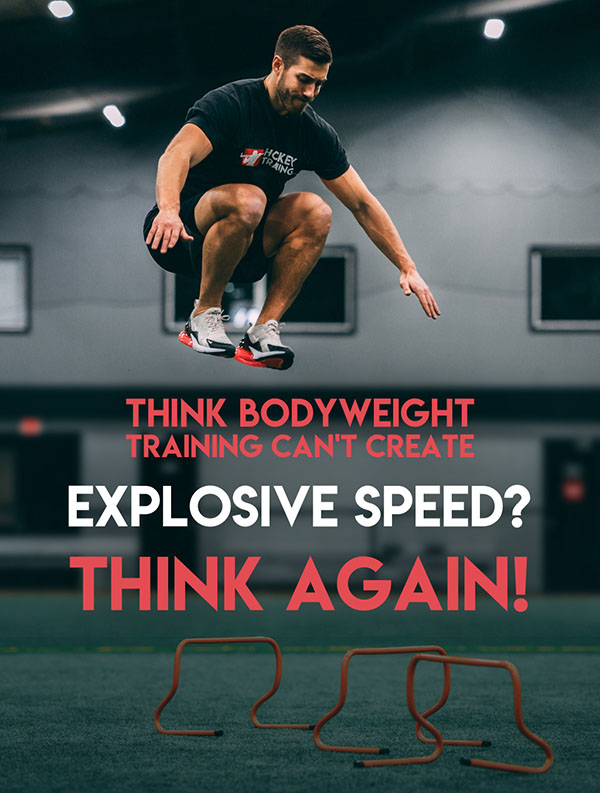
The more traditional bodyweight exercises include push ups and squats, the challenge most parents and coaches run into is designing a hockey training program that has an effective way of increasing and/or decreasing the difficulty of an exercise to meet their needs and abilities.
But, this isn’t an obstacle to creating a fully periodized youth off-season hockey program. Not by a long shot.
Take a push up, for example.
If you want to make it less difficult, you have a ton of options.
You can change your hand position, establish pauses throughout the set, put your knees down, increase your base of support, or reduce the range of motion.
To make it more difficult, you have just as many options.
You can change your hand position, force isometric pauses, perform failure sets, pre-exhaust the muscles before doing push ups, slow down the tempo, increase the range of motion, or elevate your feet to place a greater load of your total bodyweight on the upper body musculature active in the push up.
These variations won’t only increase the difficulty of the exercise, but they can also increase the range of motion and therefore recruit more muscle fibers per rep.
In a general sense, an increase in reps will improve your endurance. While strength and muscle gains are going to be found by increasing the intensity of the exercise by decreasing your leverage, working through larger ranges of motion, or by adding a plyometric component.
Bodyweight training is no joke, I have hundreds of hockey players who have gone through my bodyweight-only programming with massive success.
Outside of the sport of hockey, to assess the effectiveness of bodyweight-only training, you don’t need to look any further than checking out the strength, power output, and extreme athletic capability of elite gymnasts.
Legends of bodyweight training and Olympic medal winners have used bodyweight-only techniques their entire lives with massive success.
Let me tell you something…
Despite what everyone says you need, you don’t need to pick up a weight to get a GREAT workout in.
Sure, weight training is ideal for optimal results once you are over 15 years old and already have a few years of bodyweight training under your belt.
But before that point, it’s completely unnecessary and even sub-optimal to introduce weights too early.
You heard that right, I think weight training before 15 years old is actually a sub-optimal approach (even though it’s technically safe).
Bodyweight training checks all of the boxes for dryland hockey performance development and can be a tremendous tool in your arsenal as a coach/parent to better train your youth hockey players.
I know you might be thinking…
“What are the advantages of bodyweight training in comparison to weight training? Why do you think it’s a better approach for youth athletes?”
That’s a great question because there’s a ton of advantages to discuss that most trainers in your area will never break down for you.
Let’s explain them one by one, so you know what you’re getting into when you start incorporating some bodyweight-only training into your off-season youth hockey training program.
Versatility: Bodyweight training is suitable for both advanced hockey trainees and brand-new beginners because each exercise has so many variations to make it either harder or easier on the athlete’s current ability level.
Convenience: All you need is your body, so your youth hockey player can get a great workout anywhere, anytime. Not to mention, he won’t have to go to the gym at all and risk being totally intimidated by some dude throwing weight around and yelling beside him.
Cost: Bodyweight training costs you next to nothing in comparison to other training programs that demand lots of very expensive machines, plates, cardio equipment, and specialty bars.
Efficient: Even people with the busiest of schedules can sneak a bodyweight workout in. You can do these anywhere, anytime, and they will all take a half-hour or less. Additionally, the minimum equipment needed allows for the quickest transitions in between exercises (no more waiting for machines at the gym!) and shorter rest periods.
Adaptability: Bodyweight training does not need to be just a warm-up or cardio session. Bodyweight training exercises can be placed in a program and performed in a way to provide hockey-specific strength and muscle gain across a periodized off-season program.
Compound Movements: Almost all bodyweight exercises involve multiple joints and several different muscle groups firing simultaneously. These exercises, when alternated back and forth in a high-intensity fashion, have been demonstrated to increase circulating concentrations of health-promoting hormones, which are largely beneficial towards both muscle gain and fat loss.
Core strength: The core contains approximately 29 different main muscles, and bodyweight training alone can engage all of these by hitting them directly or by using them in a stabilizing challenge. This won’t only give you some additional armor to prevent injury out on the ice, but it can directly translate to your speed, agility, balance, and shot power.
Nervous System Adaptability: Through bodyweight-only training, you expose your muscle system and nervous system to hundreds of different coordination patterns and you force the body to execute these patterns under varying degrees of stress and fatigue. This gives you that wide foundation we talked about previously in the article so that your long-term performance career has a higher peak potential than it otherwise would have.
All-Around Increased Hockey Performance: Bodyweight training forces you to build a functional, athletic physique because you are forced to be maximally coordinated throughout every single movement and express force in many awkward ways without the stabilization assistance that a machine would give you. You will build lean, athletic, and symmetrical muscle that will be able to function with a high level of mobility that you will see a direct transfer over to hockey performance. Put another way, when all you have is your body, you start to know how to use it really well.
Bodyweight training has been an incredibly effective tool for conditioning, agility, coordination, balance, power development, increasing strength, burning body fat, building muscle tissue, and pushing the limits of human performance for centuries.
Bodyweight training, when done correctly, is the real deal.
Too many parents think that it’s “better” to use weights early, but I disagree entirely.
Weight training can wait for when the body needs it more (after the onset of puberty), until then, bodyweight-only training isn’t only safer — it’s actually better for producing hockey-specific results.
Bodyweight training is just like any other form of training, over time, you will continue to make linear progress so long as you continue to apply an overload stimulus to each and every workout.
Overload to a muscle can be provided through an increase in total body weight applied to a movement, an increase in the range of motion you move through, a different angle of movement, a decreased or increased rest period, a longer time under tension, isometrics, and any other variation you can think of.
Bodyweight training’s only limit is your mind.
When you utilize the training principles that we know are deeply rooted within the scientific literature, you can design an amazing bodyweight plan to improve your all-around hockey performance in a single off-season.
Fun Games for Hockey Performance
If you are a parent or a coach working with youth hockey players, you have probably realized the need for fun to be a critical factor in their training.
Especially when working as a strength and conditioning or performance coach, getting kids to actually “buy in” to the training is crucial in developing the physical characteristics needed both in the short-term and long-term process of being a high-level hockey player.
Kids want to have fun, and rightly so, as enjoyment is the original intent behind playing sports in the first place. We need to respect that both on and off the ice.
We as coaches and parents also want to feel the time we spend with our kid’s dryland training is productive, so making sure there is an intent and purpose for everything we do is important as well.
It’s not just fun, its training disguised as fun. This way, it’s a win-win for both kids and adults.
This is where hockey specific fitness-based games can come into play.
It’s the best possible way to make hockey training science still FUN for your kids.
Well-thought-out games offer the fun kids crave while still providing the stimulus that hockey coaches are aiming for to enhance performance out on the ice.
Some parents apply too boring of a training schedule for their kid to the point where they end up quitting, so, applying some principles of training to the games you are playing is a great idea to keep their dryland programming fresh and exciting.
But, how do we target the hockey specific training we want to see through games, so they actually improve their on-ice performance?
Beginning with common games with simple objectives is always a great place to start—think tag, capture the flag, dodgeball, crab walk soccer, red light/green light, catch, ultimate frisbee, and other games similar in nature and design.
But once you settle on the basic premise, adjusting the variables is where you change how the game is played and the demands you’ll place on your athletes.
Understand the controllable factors of games that you can manipulate to get a desired response:
- Time frame
- Equipment
- Playing surface
- Amount of space
- Rules
All of the above factors can be manipulated and formed around what outcome you want to achieve (i.e. what you want them to get better at) and can help you break free from the traditional games kids already play that, although fun, won’t help their hockey performance much.
By using these main controllable factors, you can create and shape games that not only develop athletic qualities conducive to hockey performance but can also reinforce the skill development you have taught them that are more hockey-specific.
Put simply, they become both more fit and technically better at the hockey skills you have shown them in practice through playing fun games outside of practice.
It’s all about introducing variables that incentivize kids to play a certain way, but still allow plenty of freedom (and lots of fun!).
That freedom creates an environment where kids feel more confident experimenting with different athletic solutions, which is a key benefit of utilizing games as training.
The gameplay itself also offers immediate feedback on the success of those different strategies, which can be a lot more powerful than a coach’s cue or instruction.
For example, if you want to develop balance and stability, you can manipulate the amount of surface space available for the athletes to play on. A smaller surface can demand greater balance.
It could also mean placing the athlete on a limited body surface like the hands or feet, such as games that are based around crouching positions or quadruped positions.
A personal favorite that serves well for strength, balance, and mobility is a game of crab walk soccer in which kids play soccer matches up to a certain goal number and remain in a crab walk position for the entire duration of the game.
The same principle could be applied to other common games like Tug-of-War, which becomes incrementally harder when played standing on a box or on a board.
Another example is if you want to develop aerobic capacity, you can manipulate the time frame or playing area.
The longer you play, the longer the heart rate stays up. The larger the space, the slower and more consistent the pace of play usually becomes. Put another way, these are just simple variations that offer a more fun way to do your aerobic conditioning.
Those exact same principles can be inverted to create anaerobic games.
You can manipulate the playing space available to create harder directional changes, with a smaller space usually requiring more aggressive cutting maneuvers than a larger space, thus building anaerobic outputs and improving agility.
A personal favorite of mine for anaerobic and agility training would be a simple game of 3-on-3 basketball, another excellent example of something to improve alactic power (explosiveness) and reaction time could be playing dodgeball in a small arena.
A crucial component in developing these games, however, comes down to the rules and implements you utilize.
Games with kicking involved become very different when a soccer ball is replaced with a football or tennis ball, for example.
As a coach and leader, you set the boundaries and parameters for the game by creating scenarios that put your athletes in angles/positions you want to see that will translate to an on-ice setting.
For example, if you want to reinforce change of direction positions and skill, create a game that requires them to get low and reach for something at high speeds. This forces them to change levels, incorporate high-velocity direction change, lower their center of gravity, and accomplish all of this while still being highly reactive/coordinated because they are reaching for something.
This can be done in many ways, both in a team setting and in one-on-one formats (again, basketball game variations work well here as an example).
You may want to develop spatial awareness and coordination with athletes, in which you could play a game of obstacle tag by adding additional objects and variables into the game of tag
As an example, have them be in a small area, but, draw circles on the ground that are “off-limits” that they can’t step into — this helps develop the same parts of the brain that could be connected to defensive/offensive awareness on the ice).
By manipulating the rules and implements you use for a game, you begin to control the adaptations that can occur.
This is no different than manipulating the principles and variables of real hockey training program design, you’re just doing it in a more creative way for kids to enjoy.
Although sports and skill coaches will use games that more closely reflect the sport at hand, they too can enhance their athlete’s development by tweaking certain variables.
For example, you could play a hockey game using only half of the rink and implement the rule where each team may only pass once per possession before being forced to shoot – this can help develop more confidence and competency in one-on-one game situations and teaching them how to be patient in tight spaces.
Striking the perfect balance of fun and hockey-specific athletic development for your youth hockey athletes may take some trial and error, but don’t be afraid to get creative.
The #1 thing you must not lose sight of is that the games should be fun for the athletes.
If you can accomplish that, you’ve already won 50% of the battle.
Don’t be afraid to ask the kids questions and get feedback on the games you create.
However, it’ll be fairly obvious when your athletes are really enjoying a game from the big smiles and you’ll be able to see if it was adequately fatiguing or not.
By understanding the controllable variables in a game, you can combine it with the knowledge of physiology and the knowledge of speed and agility skills you already have as an informed parent or hockey coach.
If you understand those principles, then the only thing that will limit your ability to use games effectively in dryland training is your creativity.
The Solution To Help Your Kid Become A New And Improved Hockey Player
The above information can be utilized to design an extremely effective youth-specific off-season to improve your kid’s all-around hockey performance.
But, if you want a complete “done for you” solution, the all-new Youth Off-Season 2020 Hockey Training System was designed to take all of the guesswork out of it for you so you can rest assured that your kid is doing everything in both the safest and most effective way.
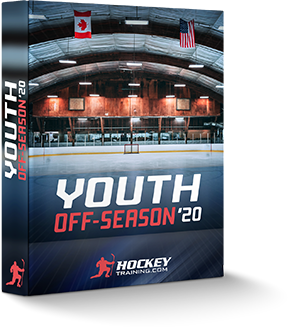
This complete bodyweight-only training system includes six phases of an elite off-season youth hockey training program that you can perform at home and anytime you want.
Beyond this, it also includes 20+ different fun game templates that you can use that are specific to hockey strength, speed, agility, and conditioning development.
Real progress comes from real hockey specific training, and this type of programming only comes from a hockey performance specialist.
You can’t find hockey-specific results in a non-hockey-specific program, and this is something rarely talked about in the hockey world.
Most youth hockey players just “stay active” in the off-season. Although this isn’t a bad thing at all, after going through this article, you can start to see how general “staying active” really is.
Instead, I recommend coaches and parents incorporate activities that are still very fun and engaging for kids but have a stronger foundation of sports science behind them to translate into real hockey performance.
The days of guessing and hoping your kid will become a better hockey player are over – get instant access to the Youth Off-Season 2020 Program here so your kid can leave fans, coaches, and scouts jaws on the floor with how much progress they have made in a single off-season.
Final Thoughts
I hope I was able to articulate the unique design of true youth-specific off-season hockey training and how this time period in their life represents the most critical window for creating both short- and long-term hockey performance potential.
Dealing with the needs of the off-season as it relates to hockey performance potential and reducing injury risk demands that you understand how to train youth hockey players correctly so that you can avoid some of the landmines found within the programming that your typical “next door” personal trainer would make.
Youth hockey program design and making it fun are equally important and constantly feed into each other as your off-season progresses.
The marriage between these two concepts will give you the objective performance results to validate the approach when you see their performance on a totally different level in the next season.
Ignoring the principles of program design that make up the foundation of your dryland training is a one-way ticket to having a minimally productive off-season.
You can’t expect your kid to get better by “winging” their program design.
Many hockey athletes out there don’t improve their performance very much from year-to-year and the #1 reason this happens is that they routinely overlook the complexity behind real program design, or, they try to train their kids like mini-adults (which is a huge mistake!).
Let me tell you something, you’ve been lied to.
The hardest worker in the room does NOT always get the best results.
Instead, it’s the hardest worker who can put his/her efforts into the most intelligent areas for hockey performance enhancement who is going to win in the end.
Why?
Because no matter how hard you work on a sub-optimal program, you’re still going to receive sub-optimal results.
Youth hockey players need to be on a youth-specific hockey training plan.
Be the hockey player who puts his efforts into an optimal hockey training program and blows his competitors away next season by jumping on the Youth Off-Season 2020 Hockey Training Program.
Youth Podcast Episode
Elite Youth Off-Season Training 🏒 – EP97





